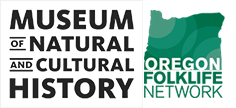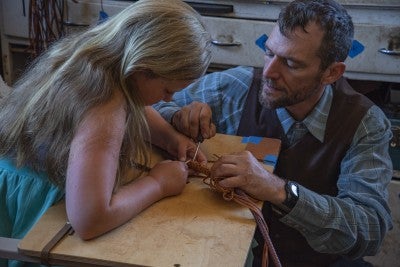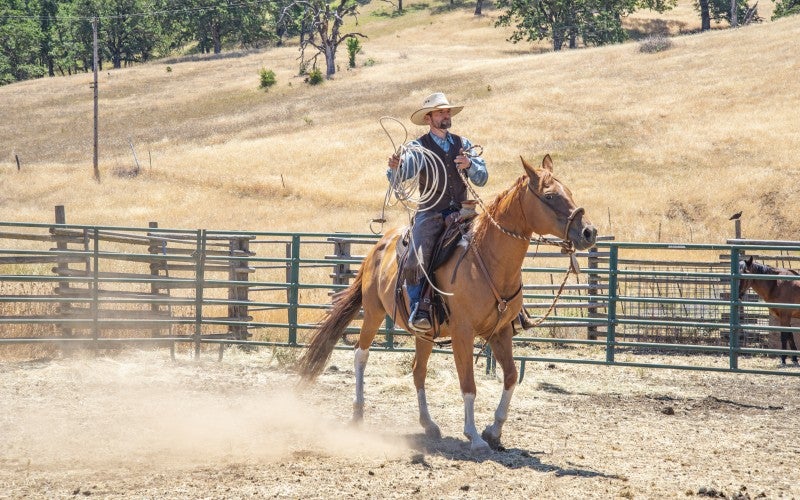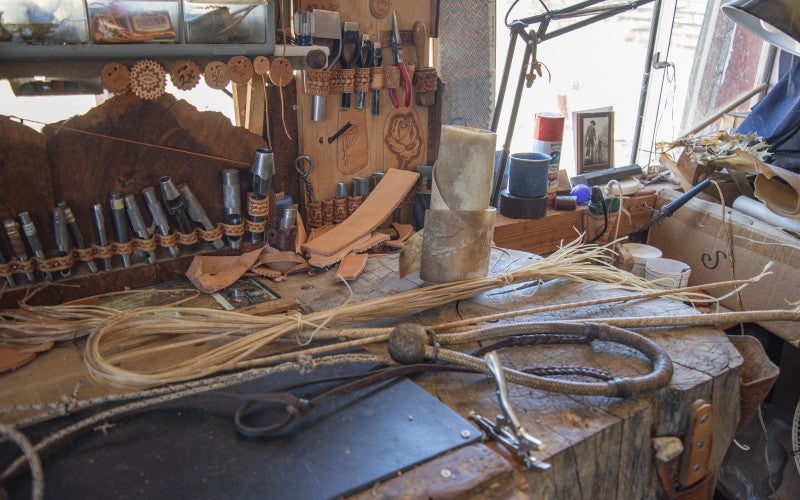Steve Harris (Roseburg) is a gear and saddle maker in the Spanish California vaquero tradition. A horseman and rawhide braider, he makes hackamores, reins, and bridle sets. He also cures his own hides, cuts his own strings, and builds the occasional saddle.
Bio
Steve Harris (Roseburg) is a gear and saddle maker; he describes himself as “a trenzador y talebartero, . . . a horse gear [maker] in the Spanish Californian tradition.” A horseman and rawhide braider, Harris braids hackamores (a type of horse headgear with a noseband instead of a bit), reins, and bridle sets. He also cures his own hides, cuts his own strings, and builds the occasional saddle. In 1999, Harris opened his own business in Roseburg and focused on braiding, gear making, and saddle repair. Though he didn’t set out to do the last, he admits that he learned a lot by fixing saddles and meeting the ranchers and cowboys.
Harris, who grew up around his family’s horses, explains that he was born a horseman but not vaquero, which came later. As he tells it, his grandfather, who sold livestock and rehabbed horses, put on him on a horse when he was a tiny boy, and he never recovered. Harris started braiding in 1993, when he was about fifteen; he became fascinated by a half-braided button—an intricately woven decorative and functional knot found on reins and other gear. “I liked that braiding . . . and the way the strings related to each other, inferred what should be done next. The symmetry pleased me. It was just really satisfying. And I really like craftsmanship of all kinds.” Harris continued to braid throughout high school; a Supervised Ag Experience taught him how to translate his passion into a business. After school, he went out to Eastern Oregon to cowboy with his older brother, who introduced Harris to the world of buckaroos and vaquero horsemanship that traced its roots back through Spanish California, Mexico, Spain, Africa, and Arabia. He learned to work in partnership with a horse, doing real work in severe weather and out in nature. While taking a saddle apprenticeship in Idaho, Harris worked for rancher Dan Carlson, a friend and mentor who taught Harris about the ranching business, and how to mend fences, brand calves, and trail cattle out in the Snake River Breaks.
Over the years, Harris adopted several other mentors, including reinsman and bootmaker Walt Clemmons, rawhide braider Duff Severe, rancher and blacksmith Cy Swan, and saddle makers Terrance McGowan and Mario Hanel—all “superior craftsmen” who motivated him to be not just a better gear maker, but a better man. McGowan challenged him to think deeply about horses and how they move. Saddles, hackamores, reins and bridles all must work together with the horse and the rider. Harris explained that the saddle especially is the interface between horse and rider. The “saddle has to enable the horse to be what it is: an athlete, and to do his job.”
For Steve Harris, a good piece of gear is functional, it does the job of enabling the rider to work with the horse, to communicate with little stress. “Ride the horse with your intent,” he tells his children. “Figure out what you want to do, what you want the cow to do, and what you need the horse to do.” The bosal (called a hackamore when tied with reins called a mecate) enables the rider to communicate with the horse. “A good hackamore is not floppy but alive—the nose button [a long piece vs. the short buttons] has a great many ‘hinges’ that facilitate comfort and rider/horse communication.”
Harris believes that his mission is not just braiding beautiful pieces, but making gear that is functional and honorable. As his mentors taught him, his goal is to make the connection between rider and horse better. The Harris family has a saddleshop, and they exhibit gear at traditional horsemanship competitions where they often donate a prize hackamore – this has provided valuable feedback from accomplished riders. He and his wife are raising their children to be people of integrity, to love and respect horses, and to braid in a way that honors the tradition. Harris explains, “We are not making sculptures, we are making gear—the art is horsemanship.”




